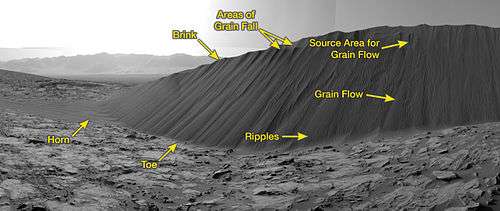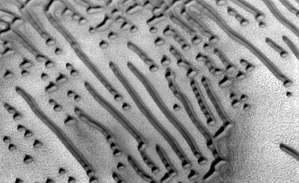List of extraterrestrial dune fields

This is a list of dune fields not on Earth which have been given official names by the International Astronomical Union. Dune fields are named according to the IAU's rules of planetary nomenclature. The relevant descriptor term is undae. As of now, the only two solar system bodies, besides Earth, with named dune fields are Venus and Mars. Dune fields have also been discovered on Saturn's moon Titan,[1] and a field of giant ripples has been identified on comet 67P/Churyumov–Gerasimenko.[2]
Venus
There are three officially named dune fields on Venus. They are named after desert goddesses, as per the IAU's rules. They are listed below.
Mars

There are six officially named dune fields on Mars, which are named after nearby classical albedo features in accordance with the IAU's rules. Five of them lie between 75°N to 85°N, between Planum Boreum and Vastitas Borealis. These dune fields span over 200 degrees of longitude. The sixth, Ogygis Undae, lies on the southern hemisphere of Mars. They are listed below.
Unofficial field names

(Curiosity rover; 17 December 2015).
- Namib Undae
- Bagnold dune field, Gale crater. This dune field was explored by Curiosity between initially between mission Sols ~1174–1248, where the rover investigated High dune, and Namib dune. Three orders of bedform were identified: wind ripple, large ripple (or wind drag ripple[4]) and dune.[5] Sand grains in this section of the dune field had a modal grain size of 120 μm[6]
- As part of the Mars Exploration Rover mission, a small dune field unofficially named El Dorado on the south side of Husband Hill in Gusev crater was investigated by the Spirit rover from sols 706 to 710.[7] Analysis of El Dorado showed that it consists of black wind-blown sand which is "well-sorted, well-rounded and olivine rich.[8]

- The Hagal dune field is named after Frank Herbert's novel Dune and the fictional planet Hagal. The field is also known as the "Martian Morse Code" due to the similarity of the Dune shapes to Morse code dots and dashes.
- Nili Patera dune field
Titan
References
- ↑ "Titan's Seas Are Sand". Archived from the original on 29 September 2006. Retrieved 21 November 2006.
- ↑ Jia, P.; B. Andreotti; P. Claudin (March 2017). "Giant ripples on comet 67P/Churyumov–Gerasimenko sculpted by sunset thermal wind" (PDF). Proceedings of the National Academy of Sciences. 114 (10): 2509–2514. arXiv:1703.02592. Bibcode:2017PNAS..114.2509J. doi:10.1073/pnas.1612176114.
- ↑ "USGS Gazetteer of Planetary Nomenclature: Abalos Undae". Retrieved 8 August 2007.
- ↑ Lapotre, M. G. A.; Ewing, R. C.; Lamb, M. P.; Fischer, W. W.; Grotzinger, J. P.; Rubin, D. M.; Lewis, K. W.; Ballard, M. J.; Day, M. (2016-07-01). "Large wind ripples on Mars: A record of atmospheric evolution". Science. 353 (6294): 55–58. Bibcode:2016Sci...353...55L. doi:10.1126/science.aaf3206. ISSN 0036-8075. PMID 27365444.
- ↑ Ewing, R. C.; Lapotre, M. G. A.; Lewis, K. W.; Day, M.; Stein, N.; Rubin, D. M.; Sullivan, R.; Banham, S.; Lamb, M. P. (2017). "Sedimentary processes of the Bagnold Dunes: Implications for the eolian rock record of Mars". Journal of Geophysical Research: Planets. 122 (12): 2544–2573. Bibcode:2017JGRE..122.2544E. doi:10.1002/2017je005324. ISSN 2169-9097. PMC 5815379. PMID 29497590.
- ↑ Ehlmann, B. L.; Edgett, K. S.; Sutter, B.; Achilles, C. N.; Litvak, M. L.; Lapotre, M. G. A.; Sullivan, R.; Fraeman, A. A.; Arvidson, R. E. (2017). "Chemistry, mineralogy, and grain properties at Namib and High dunes, Bagnold dune field, Gale crater, Mars: A synthesis of Curiosity rover observations". Journal of Geophysical Research: Planets. 122 (12): 2510–2543. Bibcode:2017JGRE..122.2510E. doi:10.1002/2017je005267. ISSN 2169-9097. PMC 5815393. PMID 29497589.
- ↑ "Mars Exploration Rovers Update: Spirit Descends Husband Hill as Opportunity Works at a Standstill on Olympia". Retrieved 21 November 2006.
- ↑ "Recent results from the Spirit rover at Gusev crater" (PDF). Retrieved 21 November 2006.
- 1 2 3 Arnold, K.; J. Radebaugh; C. J. Savage; E.P. Turtle; R.D. Lorenz; E.R. Stofan; A. Le-Gall & the Cassini Radar Team. "Areas of Sand Seas on Titan from Cassini Radar and ISS: Fensal and Aztlan" (PDF). 42nd Lunar and Planetary Science Conference, March 7–11, 2011 at The Woodlands, Texas. LPI Contribution No. 1608. Lunar and Planetary Institute. p. 2804.
- 1 2 Le Gall, A.; M.A. Janssen; L.C. Wye; J. Radebaugh; R.D. Lorenz & the Cassini Radar Team (September 2010). "Regional variations among Titan's dunes: Belet versus Fensal dune fields" (PDF). European Planetary Science Congress 2010 Abstracts. 5: 247.
A large portion of this article was sourced from the Gazetteer of Planetary Nomenclature, the official IAU database of planetary names.
- Ralph Lorenz; James Zimbelman (2014). Dune Worlds: How Wind-blown Sand Shapes Planetary Landscapes. Springer. ISBN 978-3-540-89724-8.
